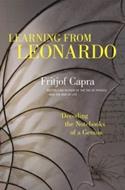Learning from Leonardo
Leonardo da Vinci was a brilliant artist, scientist, engineer, mathematician, architect, inventor, writer, and even musician—the archetypal Renaissance man. But he was also, Fritjof Capra argues, a profoundly modern man. Not only did Leonardo invent the empirical scientific method over a century before Galileo and Francis Bacon, but Capra’s decade-long study of Leonardo’s fabled notebooks reveal him as a systems thinker centuries before the term was coined. He believed the key to truly understanding the world was in perceiving the connections between phenomena and the larger patterns formed by those relationships. This is precisely the kind of holistic approach the complex problems we face today demand. Capra describes seven defining characteristics of Leonardo da Vinci’s genius and includes a list of over forty discoveries Leonardo made that weren’t rediscovered until centuries later. Leonardo pioneered entire fields—fluid dynamics, theoretical botany, aerodynamics, embryology. Capra’s overview of Leonardo’s thought follows the organizational scheme Leonardo himself intended to use if he ever published his notebooks. So in a sense, this is Leonardo’s science as he himself would have presented it. Leonardo da Vinci saw the world as a dynamic, integrated whole, so he always applied concepts from one area to illuminate problems in another. For example, his studies of the movement of water informed his ideas about how landscapes are shaped, how sap rises in plants, how air moves over a bird’s wing, and how blood flows in the human body. His observations of nature enhanced his art, his drawings were integral to his scientific studies, and he brought art and science together in his extraordinarily beautiful and elegant mechanical and architectural designs. Obviously, we can’t all be geniuses on the scale of Leonardo da Vinci. But by exploring the mind of the preeminent Renaissance genius, we can gain profound insights into how best to address the challenges of the 21st century.
-
Autore:
-
Anno edizione:2013
-
Editore:
-
Formato:
Formato:
Gli eBook venduti da Feltrinelli.it sono in formato ePub e possono essere protetti da Adobe DRM. In caso di download di un file protetto da DRM si otterrà un file in formato .acs, (Adobe Content Server Message), che dovrà essere aperto tramite Adobe Digital Editions e autorizzato tramite un account Adobe, prima di poter essere letto su pc o trasferito su dispositivi compatibili.
Cloud:
Gli eBook venduti da Feltrinelli.it sono sincronizzati automaticamente su tutti i client di lettura Kobo successivamente all’acquisto. Grazie al Cloud Kobo i progressi di lettura, le note, le evidenziazioni vengono salvati e sincronizzati automaticamente su tutti i dispositivi e le APP di lettura Kobo utilizzati per la lettura.
Clicca qui per sapere come scaricare gli ebook utilizzando un pc con sistema operativo Windows




